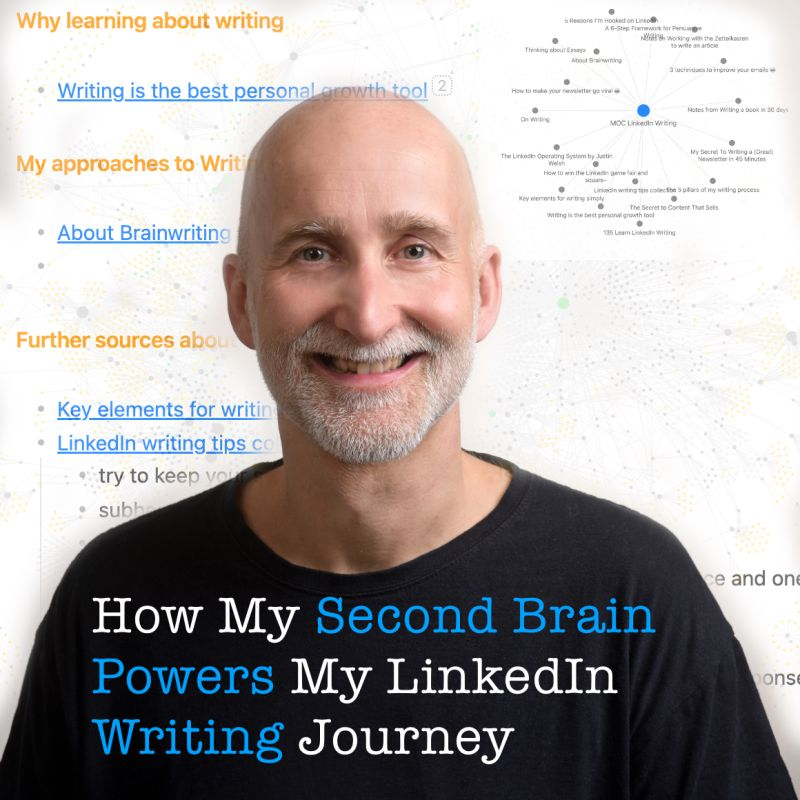How to use your Second Brain to learn a new skill
LinkedIn Post
Post at LinkedIn

How My Second Brain Powers My LinkedIn Writing Journey
(🧠💡)
I’ve turned my writing into a systematic pursuit of knowledge, utilizing my Second Brain.
Here’s my system:
‾‾‾‾‾
↳ Structured Learning: I use the PARA method to organize my writing knowledge, ensuring each lesson builds upon the last.
↳ My Map of Content (MOC) serves as a dynamic index, connecting writing concepts for deeper understanding.
↳ Integrating Existing Knowledge: I scan my Second Brain to merge new information with existing insights, sparking creativity.
↳ Streamlined Research: I capture highlights with Matter, transfer them to Obsidian, and import Kindle notes for seamless project integration.
↳ Spontaneous Ideation: My digital scratchpad captures fleeting inspiration for unique content ideas.
↳ Daily Practice + AI feedback: I apply what I learn with every post and refine drafts using context-aware AI suggestions.
↳ Writing Library for Reference: I build a comprehensive resource for self-analysis, with each post available in my Second Brain.
↳ Tracking Topic Evolution: I monitor my content themes over time.
↳ Feedback Integration: Audience insights captured in my Second Brain fuel my continuous learning.
Want to see my writing journey mapped to Bloom’s Taxonomy for learning?
Stay tuned for my next post!
Join My Journey! 👉 Follow me for tips on building your own knowledge system.
Content preparation
How I grow my writing skills with my Second Brain
I’m currently learning about writing on LinkedIn. On a daily base I use my Second Brain for writing and growing my insights on writing. Here is a brief overview on aspects how I leverage my Second Brain for that:
- I have a dedicated project in my PARA structure for Learning about Writing
- I work with a Map of Content (MOC) as index note to connect several aspects of writing
- I scanned my Second Brain for references that connect to my topic and grew my MOC with already existing thoughts. With that I follow the approach to connect new learnings with existing knowledge.
- While exploring the topic through online research I capture to Matter, then read in Matter, Highlight and use the Obsidian plugin to have the notes with highlights automatically created in your Second Brain. I link these captured information in the MOC.
- When reading books, I prefer reading on Kindle, taking highlights and using the Obsidian Kindle plugin to capture these highlights in Obsidian. Again connect with your MOC
- I externalize my thoughts while learning. I do this with an extra note in my project, where I just dump sparks and spontaneous thoughts.
- I apply my skills daily via writing a post. I create the post in Obsidian and scan for knowledge I can leverage using Smart Connections AI inside my Second Brain. Then I use AI to help me refining my posts, based on my learnings about several aspects for writing, that I provide as context.
- With that I have all my posts and drafts available in my Second Brain. I can cross reference, recombine and also keep an overview about my topics.
- I maintain a list of topics to post about in my Todoist task manager. Every time I come across an idea to write about I add it to my list of topics. When something extends that idea, I add a short note to the task
- With feedback from post engagement, conversations with others I evaluate what is working an tune my approach further. I capture that feedback as an extra note in my project and highlight the key insights and what to try next
Mapped to Bloom’s Taxonomy
[[Bloom’s Taxonomy]]
Remember
- I have worked through many basics of writing, attended courses, noted down essential aspects, and can access them quickly.
Understand
- I have grasped the concepts of concise writing for short attention spans, understand how carousels, images, and storytelling work. Additionally, I understand the 5 Lightbulbs marketing approach.
Apply
- I apply writing daily with every new post and each comment. I vary the subject areas I write about and utilize the different formats I have learned.
Analyze
- I observe how various components—text, text structure, image, image with text, carousels—interact. I analyze the writing and behavior of others. I analyze weekdays and topics.
Evaluate
- Based on feedback and experiments, I can assess which topics are in demand. I can determine on which weekdays and at what times publishing is sensible.
- I can evaluate different described approaches to see which ones work for me.
Create
- I combine writing with AI to receive feedback, further optimize sentence structure, and build templates that facilitate the writing process.
- I link writing with additional engagement funnels.
- I combine text, image, and soon video to reach a new level of creativity and expression.
CTA
👉 Follow me to gain more insights about Smart Learning through my daily posts
Posted on LINKEDIN on 2024-04-22_Mon